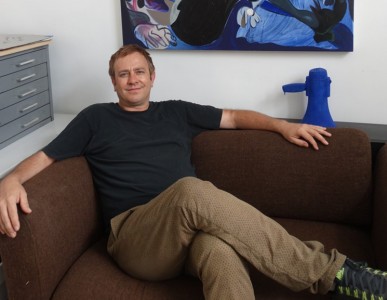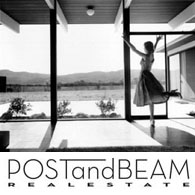Courtesy of LA Weekly
BY MARISSA GLUCKFRIDAY, AUGUST 14, 2015
Photo by Kate Jordan
In Los Angeles, the slashie phenomeon is indelibly ingrained into a culture that celebrates creative ambition. You see it in the waiter/actor/model that shuffles from auditions to brunch service, the graphic designer/Pilates instructor designing a new web site, and the barista/musician pulling an espresso.
For Chicago transplant Keith Couser, bridging the worlds of art and real estate have allowed him to create a niche as the preferred agent for Los Angeles’ up and coming artists. As a gallerist/realtor, Couser splits his days running his compact Culver City gallery, Loudhailer, and finding homes for a growing clientele of creatives including art world darlings such as John Knuth, Julian Hoeber, and Mark Hagen.
Couser spent almost two decades in the real estate industry in the Midwest while becoming increasingly interested in art by going to a lot of exhibits and studio visits. He eventually became a collector and then a partner in a small gallery, Bucket Rider, in Chicago.
Couser‘s expanding social network began to include more and more West Coast artists and his gallery focused on emerging talent, many of whom are now rising stars in L.A.’s art world. His gallery was the first to feature the critically lauded series of “Fly Paintings” by John Knuth, created using the excretions of 250,000 houseflies.
Four years ago, tired of Chicago winters and with an increasing number of his artist friends already in L.A., Couser made the move here. His first real estate clients were people he knew from the art world. Knuth, who helped find Couser his first apartment in L.A. when he moved here, wound up asking Couser to help him buy his first home last year. Knuth and his wife, interior designer Taylor Jacobson, found themselves priced out of Echo Park, where they had been renting an apartment.
“We couldn’t afford to buy in Echo Park. We couldn’t afford the ‘hipster hills.’ We were priced out of Highland Park, and Glassell Park, and Eagle Rock.,” says Knuth. Couser showed them about thirty homes in their price range, including properties south of the 10 and in East L.A. before they bought their house in Altadena. Knuth prioritized properties that had a two-car garage with a yard big enough to build a studio. Knuth’s work space needed to be able to accommodate his unusual materials and methods for his art, which include not only the flies, but also snakes, smoke flares, and space to build outdoor sculptures.
For Knuth, working with Couser came naturally. “He will sell you a painting, then sell you the wall to hang it on,” jokes Knuth.
One of the reasons Couser enjoys working with artists is their shared aesthetic appreciation of fixer uppers. “Artists have a better vision of what can be done,” he explains. “They can look at a property and not just see the bad, but can re-envision it.” Artists, with less predictable income than a salaried employee, also present unique challenges in terms of financing that Couser helps them walk through. “They’re also the toughest to sell houses to.”
For artists Julian Hoeber and Heather Rasmussen, Couser understood the couple’s aesthetic demands when they were house hunting in 2013. “He knew my taste, he has an eye for art, and he’s concerned with aesthetics,” says Hoeber.
Since Hoeber had a background as a fabricator, Couser knew he was comfortable with remodeling. As a result, Hoeber says, “he was a little more adventurous about what to put in front of us.” Hoeber wound up purchasing a two bedroom, one bath bungalow on a large lot that offers space for a studio.
With more and more requests for help to find studio space, Couser expanded from residential real estate to commercial, scouting for cheaper space in less obvious neighborhoods. With the post-industrial Arts District becoming less hospitable to working artists as it becomes a packaged and branded urban commodity for “artists” more likely to run a social media startup than stretch a canvas, Couser has had to become more creative.
In residential real estate, he says, “everything is on the Internet. For commercial properties you need to have the right contacts to find the right properties.” Yet as pricing for studio space increases, Couser says artists look for a detached garage they can convert into studio space in their homes.
As parts of Northeast L.A. such as Highland Park have become out of reach for first time homebuyers, Couser has expanded his searches to neighborhoods such as West Adams, South L.A. and Inglewood. “We’re still in a boom cycle,” says Couser. “So we’re casting a wide net. If someone is looking for a Craftsman, they may not be able to afford it in Pasadena but maybe they can in El Sereno. It’s a game of patience.”
Last year, with Couser’s real estate business growing, he once again opened exhibition space, in a small storefront just off La Cienega’s gallery row. His approach to the gallery reflects the same tactics he brings to real estate, exhibiting emerging artists that are less well-known locally. “I don’t chase the latest kid out of art school in LA,” he explains, eschewing the MFA feeding frenzy at CalArts and Art Center. Instead, he prefers to find talent from his Midwest connections to Cranbrook and the Art Institute.
In addition, he adds, “I work with young collectors because I was a young collector. I can remember that feeling of walking into galleries and being sized up and dismissed.”
Artists are often viewed as a double edged sword: as the trailblazers willing to live with fewer local amenities in exchange for cheaper digs but also the harbingers of gentrification. But the reality is that many of the artists Couser works with don’t want to be frontierspeople. Instead, they’re buyers much like everyone else – looking for a decent value, good schools for their kids and enough space to grow a lemon tree.
While the economy is strong and the art market is healthy, allowing more artists to become first time homebuyers, Couser is circumspect about the cyclical nature of real estate. “A bust is inevitable,” he sighs. In the meantime, as long as L.A. continues to attract new artists, new homebuyers and new art collectors, Couser hopes to serve them all.






